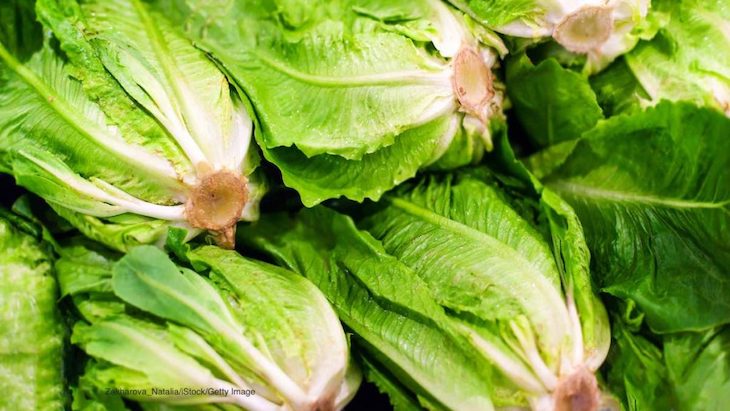Food safety experts are holding their collective breath. Now that fall is here, will there be a 2020 E. coli romaine lettuce outbreak? In previous years, by this time there has been at least one serious outbreak linked to leafy greens. Is our luck about to run out? Or have changes made by the California and Arizona Leafy Greens Marketing Agreements and government made a difference?

There has been at least one E. coli outbreak in the U.S. linked to leafy greens every year since 2017; hundreds have been sickened, dozens have been hospitalized, and several people died.
One of the issues in these outbreak developments, especially in the past several years, has to do with climate. When there has been an unusually hot and dry summer, farmers in California and Arizona have to use more agricultural water to irrigate crops. And, in past years, that water has been tainted with E. coli bacteria that allegedly came from cows on nearby factory farms.
Here’s the history of E. coli outbreaks linked to leafy greens since 2017:
- In November 2017, an E. coli O157:H7 outbreak linked to leafy greens sickened at least 25 people in 15 states. Nine people were hospitalized and one person died. In Canada, 21 people living in 3 provinces were sickened. The investigation did not identify a specific type of leafy green, a grower, or even a state where the contaminated greens were grown.
- In 2018, an E. coli O157:H7 outbreak linked to romaine lettuce grown in the Yuma, Arizona growing region sickened 210 people in 36 states. Ninety-six people were hospitalized, and there were 5 deaths. Twenty seven patients developed hemolytic uremic syndrome (HUS), a type of kidney failure. The outbreak strain was found in water samples taken from a canal in the growing region.
- In 2018, an E coli O157:H7 outbreak linked to romaine lettuce grown on the Adam Bros. farm in the Central growing region of California sickened 62 people in 16 states. Twenty-five people were hospitalized, including two who developed HUS. The outbreak strain was found in sediment in an agricultural water reservoir on the Adam Bros. farm.
- In 2019, an E. coli O157:H7 outbreak linked to romaine lettuce from the Salinas growing area in California sickened 167 people in 27 states. Thirty-five people were hospitalized, and 15 developed HUS. While several recalls were issued, no one specific grower or producer was named, but the outbreak strain of E coli O157:H7 was found in and unopened bag of Fresh Express Leafy Green Romaine from an ill person’s home in Wisconsin and in an unopened package of Ready Pac Foods Bistro Chicken Caesar salad from a sick person’s home in Maryland.
- In 2019, and E. coli O157:H7 outbreak that sickened 10 people in 5 states was linked to Fresh Express Sunflower Crisp chopped salad kits. Four people were hospitalized, and one person developed hemolytic uremic syndrome. This outbreak was caused by a different strain of E. coli O157:H7 than the outbreak linked to the Salinas romaine. While romaine was an ingredient in the salad kit, investigators couldn’t determine if romaine was the contaminated ingredient in the kit.

If you or a loved one has been diagnosed with food poisoning, you can contact attorney Fred Pritzker for help by calling 1-888-377-8900 or 612-338-0202.
Noted food safety lawyer Fred Pritzker, who has represented clients in these E. coli romaine lettuce outbreaks, said, “We hope that the changes made by the LGMA groups in California and Arizona will be enough to prevent a 2020 romaine E. coli outbreak, we’ll have to wait and see. Everyone needs to pay attention to the FDA and CDC for information this fall and winter. Produce should not be contaminated with any pathogen that can make people seriously ill.”
Meanwhile, all the consumer can do is to watch for recall notices and information about outbreaks. While it’s important to always thoroughly rinse produce before you prepare and eat it, it is not possible to completely remove pathogens from these products, especially leafy greens, which have a deeply crenelated surface where bacteria can hide. The best way to destroy E. coli O157:H7 is to heat it to 160°F, although about 2% of bacteria can survive high temperatures.
Symptoms of an E. coli infection are quite severe, so most people seek medical attention. Those symptoms include a mild fever, nausea and vomiting, severe and painful abdominal cramps, and diarrhea that is bloody and watery. In some groups, especially children under the age of 5, a potentially deadly complication called hemolytic uremic syndrome may develop. Symptoms of HUS include little or no urine output, lethargy, pale skin, and easy bruising.

If you or a loved one have been sickened with an E. coli infection or any type of foodborne illness, please contact our experienced attorneys for help at 1-888-377-8900 or 612-338-0202.




